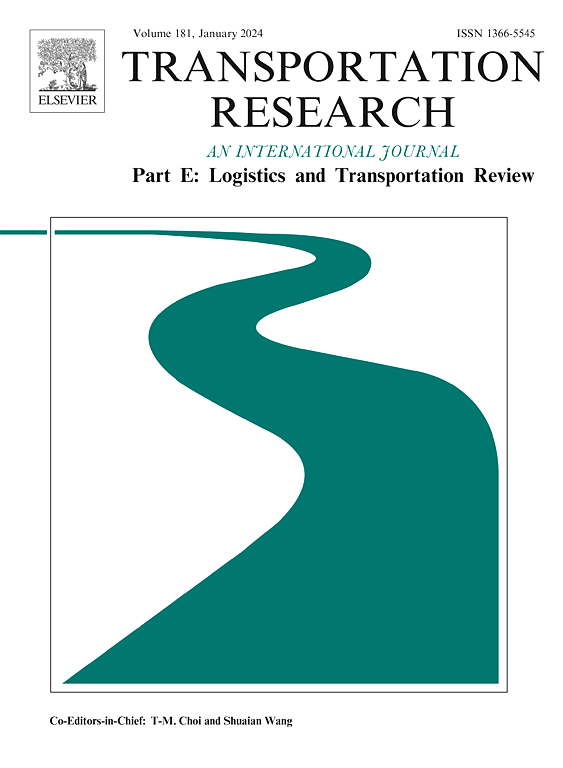Parcel delivery by vehicle and drone in ordered customer neighborhoods
IF 8.3
1区 工程技术
Q1 ECONOMICS
Transportation Research Part E-Logistics and Transportation Review
Pub Date : 2025-03-24
DOI:10.1016/j.tre.2025.104047
引用次数: 0
Abstract
We consider a last-mile parcel delivery problem where a vehicle with a companion drone visits a set of ordered neighborhoods, following a line of travel that starts and ends at the depot. The decision-maker restricts the drone to fly within the neighborhood being serviced by the vehicle and seeks to optimize the vehicle and drone operations so that the total time to return to the depot, upon completing all deliveries, is minimized. The problem is formulated as a mixed-integer program, which is enhanced via cut-set constraints and valid inequalities derived using the Reformulation-Linearization Technique (RLT). Further, we investigate the logistical and computational effects of optionally imposing street precedence rules, based on training data from numerous optimized solutions for instances constructed in Amherst, MA (USA). Our study examines the computational tractability of the baseline model, the usefulness of imposing valid inequalities, and the impact of enforcing street precedence rules. Remarkably, enforcing RLT-based valid inequalities enables, in our experience, optimal solutions for instances having up to 200 customers within manageable times, thereby yielding a practical optimization-based framework for decision-makers.
通过车辆和无人机在订购的客户社区运送包裹
我们考虑一个最后一英里的包裹递送问题,在这个问题中,一辆载着一架无人机的车辆沿着一条从仓库开始和结束的路线,前往一组预定的社区。决策者限制无人机在车辆提供服务的社区内飞行,并寻求优化车辆和无人机的操作,以便在完成所有交付后返回仓库的总时间最小化。该问题被表述为一个混合整数规划,并通过使用重新表述-线性化技术(RLT)导出的切集约束和有效不等式来增强。此外,我们基于在马萨诸塞州阿默斯特(Amherst, MA, USA)构建的许多优化解决方案的训练数据,研究了选择性施加街道优先规则的后勤和计算效果。我们的研究考察了基线模型的计算可追溯性,施加有效不平等的有用性,以及执行街道优先规则的影响。值得注意的是,根据我们的经验,执行基于rlt的有效不等式可以在可管理的时间内为拥有多达200个客户的实例提供最佳解决方案,从而为决策者提供实用的基于优化的框架。
本文章由计算机程序翻译,如有差异,请以英文原文为准。
求助全文
约1分钟内获得全文
求助全文
来源期刊
CiteScore
16.20
自引率
16.00%
发文量
285
审稿时长
62 days
期刊介绍:
Transportation Research Part E: Logistics and Transportation Review is a reputable journal that publishes high-quality articles covering a wide range of topics in the field of logistics and transportation research. The journal welcomes submissions on various subjects, including transport economics, transport infrastructure and investment appraisal, evaluation of public policies related to transportation, empirical and analytical studies of logistics management practices and performance, logistics and operations models, and logistics and supply chain management.
Part E aims to provide informative and well-researched articles that contribute to the understanding and advancement of the field. The content of the journal is complementary to other prestigious journals in transportation research, such as Transportation Research Part A: Policy and Practice, Part B: Methodological, Part C: Emerging Technologies, Part D: Transport and Environment, and Part F: Traffic Psychology and Behaviour. Together, these journals form a comprehensive and cohesive reference for current research in transportation science.

 求助内容:
求助内容: 应助结果提醒方式:
应助结果提醒方式:


